Abramite (Abramites hypselonotus)
The suborder Characoidei contains more than 1,200 species of fish in 14 families, distributed in the fresh waters of South America (more than 1,000 species) and Africa. It is also represented by several species in Central America and the south North America. Characteristic features of the characinoid structure are the presence of a chain of bones in the anterior vertebrae, like in cyprinids, and an adipose fin, without bony rays, behind the main dorsal fin, like in salmonids, for which characinoids are often called salmlers (from the word Salmo, which is the scientific name of the genus real salmon).
Characin-like fish known to be dangerous to humans are tiger fish or wolf fish (Hydrocynus goliath). With a length of 1.5 meters, they have a terrible mouth with huge teeth. Very tiny characin-like species are also known - Nannostomus. Their mouth is so small that they are not always able to swallow a mosquito larva. And bloodthirsty piranhas, which enjoy a bad reputation due to the fact that their schools can supposedly skin a buffalo in a matter of minutes, and abramites swimming vertically (head down), and nematobrikon, called by amateurs royal tetras for the luxurious tail in the form of a crown in males - all these are characinids.
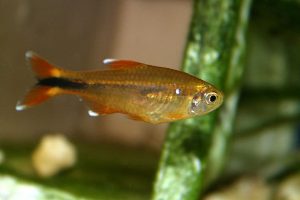 | 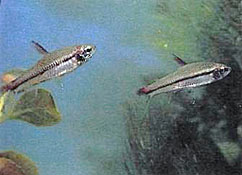 |
| Congo tetra (Phenacogrammus interruptus) | Nannaethiops unitaeniatus |
Aquariums contain more than 500 species of fish of this suborder (in our country - about 70).
Most characins are schooling fish; they live well among thickets of aquatic plants in general aquariums (20–30 liters or more for large species). The exceptions are herbivorous species, which are characterized by intraspecific aggression (distichods, leporines), and active predators. The latter must be kept with large fish that they are not able to swallow.
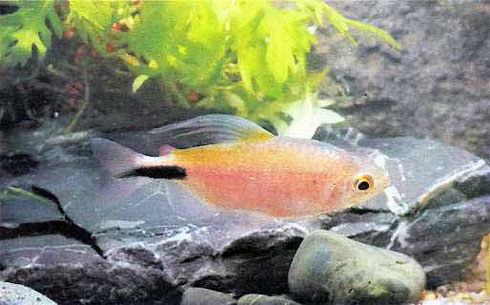
Longfin Brycinus (Brycinus longipinnis)
When breeding characins, aquarists for the first time encountered the need to select and control the chemical composition of fresh water, which undoubtedly played a role important role in the development of a scientific approach to a seemingly purely amateur hobby.
Preference is given to water of medium hardness with a neutral reaction (pH 6.8–7.2) and a temperature of 23–-25°C.
The separation of males and females, a decrease in hardness, an increase in water acidity (hardness 0.5–2.0°, pH 5.0–6.5) and an increase in temperature usually stimulate spawning. Depending on the size of the fish, spawning aquariums can hold from 2–3 to 500 liters or more.

Six-banded distichodus (Distichodus sexfasciatus)
Clean and sterile spawning grounds are the key to successful fish breeding. Practice has shown that simply rinsing the aquarium with a stream of water is not enough; it is better to wipe it from the inside with a slurry of moistened, finely ground table salt. In this case, the corners and bottom are treated especially carefully, and then rinsed with warm boiled water. For fish whose eggs are particularly sensitive, such as red neons, the spawning area is additionally rinsed with water prepared for spawning.
It is advisable to leave the prepared water of the required hardness and acidity in bottles for one to two weeks in a dark place in order to stabilize the composition of the water and reduce the bacterial background. The same water, after purification and sterilization, can be used repeatedly. Spawning in characins is portioned, that is, it actually does not depend on the time of year.

Blind tetra (Astyanax fasciatus mexicanus)
The substrate for spawning can be Thai fern bushes, Java moss, and nylon threads. The plants are thoroughly washed and sterilized, preventing small snails, cyclops, etc. from entering the spawning pond.

Astyanax bimaculatus
There are known species that build a foam nest at the surface of the water (Hepsetus), dig a hole in the sand and protect eggs (Copeina guttata), some species have internal fertilization (Coelurichthys, Diapoma).
Incubation period from one to six days. After spawning, the spawners are caught with a clean net. Since the eggs of some fish (primarily neons) are sensitive to light, the incubator aquarium is covered with black paper or cloth. To monitor the development of eggs, it is permissible to use a flashlight.

Tetragonopterus (Hemigrammus caudovittatus). Regular shape at the top, albino at the bottom
Growing fry are transferred to increasingly spacious aquariums, while gradually adapting them to ordinary tap water. Frequent water changes and constant availability of food ensure rapid and uniform growth of the fry. The fry are fed with “live dust”, artificially bred ciliates, rotifers, microworms, etc., increasing the size of the food as the fry grow.
Of the African characins, representatives of two families are most often kept in aquariums - Alestidae and Citharinidae. These fish inhabit the basins of the Niger, Nile, Congo, and Zambezi rivers. The Alestaceae family is represented in recreational waters, mainly by five genera: Arnoldichthys, Brycinus, Hemigrammopetersius, Micralestes, Phenacogrammus. The mating behavior of alestaceae is stimulated, in addition to the above factors, by bright sunlight or artificial lighting and sometimes by the addition of table salt up to 0.5–1.5 g/l. Considering the relatively large size of the fish (8–16 cm), it is better to take a larger aquarium for spawning (100 liters or more). The cytarine family can be divided into two groups, one of which contains small fish of the genera Nannaethiops, Neolebias, and the other - relatively large (up to 30 cm) - Distichodus, Paradistichodus. Nannethiops and Neolebias are easily bred in aquariums, like other characins, but the reproduction of herbivorous distichodes has not yet been sufficiently studied.
The tropical biotopes of the basins of the largest rivers in South America - the Amazon, Orinoco, La Plata - are a real paradise for characins, the diversity of which here is truly fantastic.
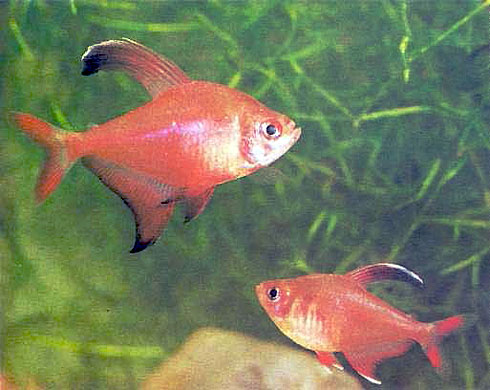
Roberts's Hyphessobrycon sp. "robertsi" - above, Hyphessobrycon bentosi - below
The Anostomidae family, represented in our aquariums by three genera: Abramites, Anostomus, Leporinus, has not yet become widespread due to insufficient knowledge of reproduction. The first successful breeding of anostomes is the merit of the most experienced Moscow aquarist M.I. Likhachev. Using the method of hormonal stimulation of spawning, he has obtained more than one generation of these funny pencil fish.
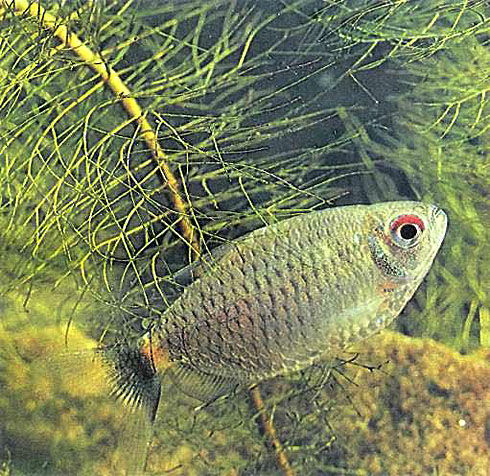
Philomena (Moenkhausia sanctaefilomenae)
A representative of the family of chilods (Chilodus punctatus) resembles anostomes in its manner of swimming upside down. Chylod breeding is well established without hormonal injections. The diet of the above-mentioned fish requires plant and animal foods.

Characin biotope (Amazon basin)
The largest family of the characinoid suborder, the Characidae, has about 700 species. Bright coloring with phosphorescent, as if luminous, spots and stripes (genus Hemigrammus, Hyphessobrycon, Paracheirodon), unpretentiousness and ease of maintenance have made these fish desirable in decorative aquariums. Among the characins, a group of fish should be distinguished that prefer slightly harder water than the rest. These are primarily Astyanax (including the amazing blind cave fish Astyanax fasciatus mexicanus), Afiocharax and Prionobrama. To successfully breed red neon, petitella, and rhodostomus, it is better to use, on the contrary, very soft, double-distilled or demineralized water with a sufficiently acidic reaction (pH 5.0–5.8).
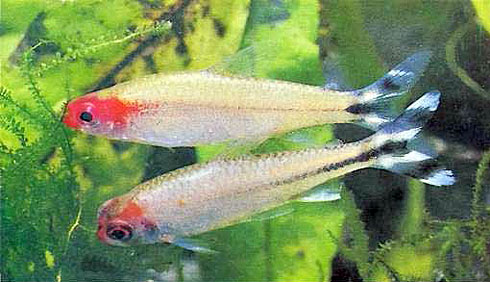
Red-nosed tetra (Petitella georgiae)
The families of Crenuchidae and Gasteropelecidae are not numerous. The first has only 3 species, the second has 3 genera (8 species). The breeding of these amazingly shaped fish has not yet been mastered, which limits their distribution in aquariums.

Weitzman's Poecilocharax weitzmani
The Lebiasinidae family, due to its variegated coloring (genus Nannostomus, Pyrrhulina), rare manner of swimming head up (Nannobrycon), careful care of eggs, non-standard type of spawning behavior (Copella arnoldi) and, most importantly, successful reproduction in captivity, is popular in aquarium culture. Interestingly, fish of the genus Copella lack an adipose fin.
The combed pike family (Ctenoluciidae) has only one representative in aquariums - the swordmouth, a frankly predatory fish reaching a length of 30 cm or more. Fish spawn easily after injection of gonadotropin hormone. Productivity is quite high (1000 eggs or more), but the desire of the juveniles to eat each other often brings everything to naught. Therefore, frequent, careful sorting of fry and constant availability of food of suitable sizes are necessary.
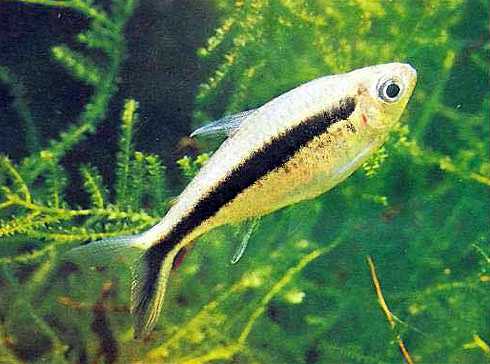
Thayeria boehlkei
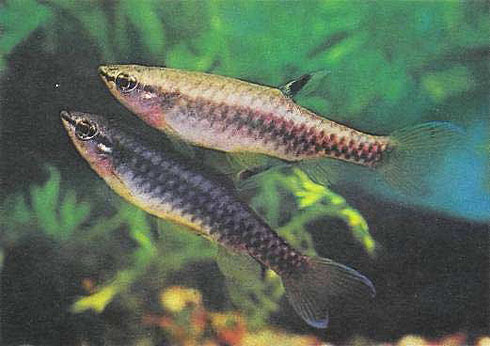
Copella stoli
Nannostomus beckfordi
Nannostomus marginatus
Swordwort (Ctenolucius hujeta)
In aquariums, piranhas grow up to 30 cm, feed on fish and meat (in some cases, feeding with plant components is advisable). Their sharp teeth and unbalanced nature make them dangerous, especially for children. Transplanting and catching must be done very carefully. Metinnis are twice as small as piranhas, they feed on plant foods - cabbage, lettuce, etc. For breeding, breeders are selected and prepared from a school of young fish.
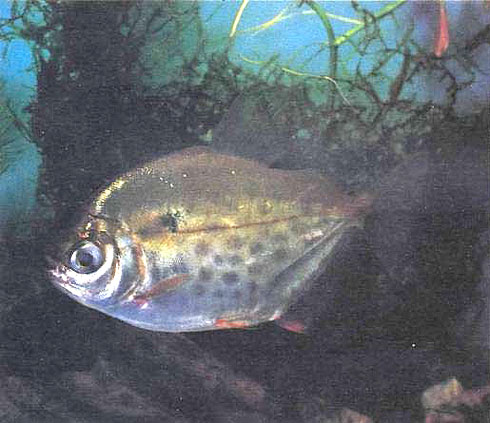
Metynnis spotted (Metynnis maculatus)
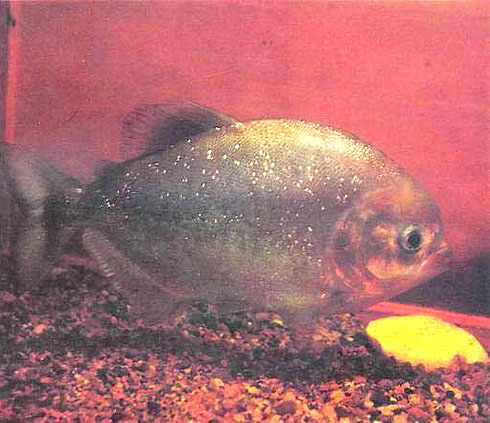
Piranha Naterrera (Serrasalmus nattereri)
To breed large fish of the piranha family, large aquariums-pools are needed - 600–800 liters or more.
Fish belonging to the suborder Characinidae or Charcoidae are considered by many to be the pearls of the aquarium hobby. Suffice it to say that it includes such different fish as the well-known piranhas and neons. In most species, the characin family is revealed by a small adipose fin located behind the dorsal fin on the caudal peduncle.
Characins, or tetras, as they are called abroad, inhabit the tropical waters of both Americas and Africa. Most of the 400 species kept in the aquariums come from the “black waters” of the Amazon and surrounding areas. They are small in size, brightly colored and gregarious. In twilight streams under the dense canopy of the tropical forest, bright colors are necessary for unmistakable recognition of relatives. The lifespan of aquarium species usually does not exceed 3-5 years, and they become sexually mature at 6-12 months. Males are brighter and slimmer than females, their abdomen is pointed, and their fins are often more magnificent. Spawning is seasonal - summer, often stretched over several months. During this time they are able to throw several times.
For breeding, fish are planted in schools in all-glass or plexiglass non-growth tanks. You can also use frame aquariums, but only those that have been in use for several years. Non-sticky eggs are swept into the water column and freely fall to the bottom. Characins not only do not care about eggs and offspring, but also devour them with great pleasure. You should not start breeding tetras if you are not familiar with other spawn-laying ones. But there are also species that are easy to reproduce - tetragonopterus, thornets, tetra von rio. It is somewhat more difficult to work with minors, erythrozonus, and flashlights. It is even more difficult to breed neons. Of the widespread characins, red neons are considered the most difficult to breed.
10-15 young fish are purchased per tribe and kept in normal aquarium conditions with an abundance of small-leaved plants and good water filtration. The temperature is not higher than 23-24 °C. The fish are fed well and fully, but overfeeding is avoided. All live food is excellent to eat. Compound feed should make up about 20% of the diet, tubifex no more than 15%, semolina is good as a substitute for plant feed.
Many manuals recommend separating males and females one to two weeks before spawning. It is much more effective to separate them in one aquarium with an opaque partition with small holes. The fish, without seeing each other, sense the presence of partners by smell, which has a positive effect on their readiness to spawn. In the spawning tank, it is necessary to install a safety net above the bottom, as described for barbs, and place 2-3 bundles of green or brown nylon threads. You can boil regular fishing line in strong tea and rinse it under the tap. The spawning tank must be sterile. The presence of bacteria is excluded. It is best to treat it with hydroperite.
Separately prepare water for spawning. In this case, one cannot do without determining hardness and acidity. Hardness should be within 2-5°, pH=6.0-6.8. There must be tannins in the water. Water is obtained by mixing the distillate with tap water passed through a household filter. Then an infusion of scalded alder cones is poured into it - 3-4 pieces per liter, or a scalded twig of pinnate is placed. It is even better to use special industrially produced elixirs.
The prepared water is kept in the dark for about a month. An indicator of readiness is the amber color of the water and the formation of small brownish lumps at the bottom. Prepared water is poured into the spawning tank in a layer of 10-20 cm, depending on the type of fish. At this time, it is necessary to once again check its hydrochemical parameters and, if necessary, correct them.
Breeders are not transplanted immediately, but gradually mixing water from the aquarium where they are constantly kept and newly prepared water in a separate vessel. This is necessary to prevent stress due to sudden changes in pH and dH. Then the temperature is gradually raised to 25-27 °C. The day before transplantation into the spawning tank, the fish are not fed. The spawning tank is placed in a dark place and only the top layer of water is illuminated with a 15-watt light bulb burning at full intensity. It is advisable to imitate natural sunrise and sunset, which are incentives for spawning. If the fish do not spawn, the spawners are replaced after two days.
After spawning, the water level is lowered to 5 cm. Unfertilized, whitened eggs must be removed with a glass tube, methylene blue or trypoflavin is added to the water and the dH is gradually increased to 10-12°. Soft water is necessary only for spawning, and for the development of eggs and larvae, hard water is much better, preventing the development of bacteria. In most characins, eggs and larvae do not tolerate bright light. The spawning tank with them must be kept in the dark. The incubation period lasts 1-1.5 days, the hatched larvae hang on the glass, and after another 4-5 days the fry swims. They start feeding with rotifers, and after a couple of weeks the young are transferred to Artemia, Cyclops or Diaptomus nauplii. There should always be a lot of food, more than the fry can eat in a day.
The difficulty of breeding some characins does not at all indicate the difficulty of keeping them. For most fish, normal water parameters, normal food and peaceful neighbors are suitable. Beginner aquarists often ask, is it possible to keep fish without breeding them? Doesn't this affect their health? You can simply hold not only characins, but also any other fish in order to admire their beauty. If you don't want to get involved with breeding, don't bother. This will not harm the fish. By the way, it is not at all necessary to maintain the sex ratio in the flock. Fish need individuals of the opposite sex only during spawning. And if there are no spawning incentives, we can assume that you have the same fish - the middle sex.
Tetragonopterus (Hemigrammus caudovittatus). One of the easiest characin fish to keep and breed. The shape of tetragonopterus resembles an ordinary roach, 7-10 centimeters long. The color is yellowish-greenish with a metallic sheen, the abdomen is silvery. There is a black stripe on the caudal peduncle. All fins, with the exception of transparent pectoral ones, are red. Currently, the natural form has been practically replaced by the albino one. Albinos are painted an even golden color with blood-red iris eyes that resemble ruby mirrors. The fish are very active, the males are not averse to fighting, but they do not harm each other. They are peaceful towards their neighbors. Tetragonopterus are omnivores. The natural form sometimes tends to bite tender plants; albinos do not have this drawback.
Tetragonopterus is not typical for characins in keeping and breeding. They can be diluted in regular tap water. A spawning area of 20 liters is required, with a water level of 30 cm. 3-4 males are planted per female. Spawning begins in the morning and in a couple of hours the female spawns from 300 to 2000 eggs. The fry can be fed with ciliates and mixed feed.
Erythrozonus (N. erythrozonus) also known under the incorrect name "gracilis". In shape, this resident of Western Guiana resembles Tetragonopterus, but is much smaller, no more than 4.5 cm. The translucent body of the graceful Erythrosonus is colored silver-yellowish. A rainbow stripe stretches from head to tail. When properly illuminated by overhead light, the fish looks surprisingly attractive, and the longitudinal stripe suddenly begins to glow and shimmer in different shades of red and blue.
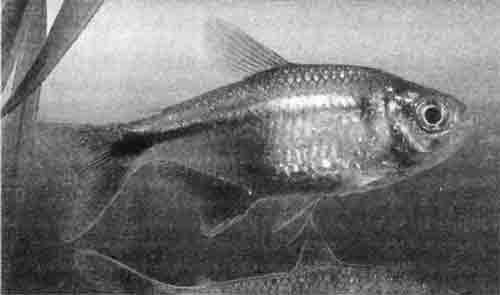
Flashlight (N. ocellifer falsus) widespread in the Amazon basin. The body is elongated, like that of Erythrosonus, up to 3.5 centimeters long, steel gray. The back is bluish. The base of the caudal fin is translucent, with a dark cross-shaped spot on it. Above it is a large golden spot-mirror. Males can be distinguished by a black cross-hatch on the anal fin. When the flashlight is in a calm state, the tail spot and the same golden eyes seem to emit rays of light. Schools of fish get along well in general aquarium with peaceful neighbors.
The spawning ground is selected with a capacity of 15 liters or more, with a bush of fontinalis or pinnate. The water level is at least 20 cm, hydrochemical parameters are described for the suborder. The light is overhead, diffused. For one female it is necessary to take two males. Spawning occurs on the 2-4th day. To do this, the spawning area is placed so that it is slightly illuminated from the window, and shaded with tracing paper. Parents do not eat eggs. At the end of spawning, they are planted and the jar is darkened. After a day, hatching occurs, and after another 5 days the fry swims. It is impossible to raise fry with artificial food, but on good live food it grows very quickly. Lanterns reach sexual maturity at 6-8 months and live up to 6 years. Adult fish are not picky about food.
Minor- under this name, several very similar species of the genus Hyphessobrycon callistus, N. serpae, N. minor, N. hasemani, N. harald schultzi and their hybrids live in aquariums. Most likely, there are few pure natural lines left now. Species and crosses have long been reliably confused due to their fertility and ease of crossing. More or less purebred fish are sometimes imported. Therefore, we will talk about fish of the callistus group, under the general name minor. The body of the fish is laterally compressed and rather high, the caudal fin is deeply notched. The high dorsal fin approaches a quadrangular shape. Dimensions 3.5-4.5 cm. Color reddish-brown, red, brick pink. There may be black spots on the dorsal fin and on the side behind the head. Fish are not demanding chemical composition water and feed. They get along well in a community aquarium. For dilution, all-glass jars with a capacity of 8-10 liters with a mesh at the bottom are used. Boiled tap water, enriched with a decoction of alder cones or elixir. It can be consumed one day after preparation. The lighting is weak and diffuse. The spawners are planted for spawning in the evening, and marking occurs in the morning. After the end of spawning, the spawners are planted, and the spawning tank with eggs is shaded. The next day, the larvae hatch from the eggs. After another 4 days the fry swims. For the first 4-5 days, the fry are fed rotifers and ciliates, then they switch to brine shrimp and microworms.
Tetra von rio (N. flammeus)- the literal translation of the absurd name, which took root thanks to some old mistake, is “fish from the river.” It is more correct to call it a “fire tetra.” She lives in the vicinity of Rio de Janeiro. The shape is close to the callistus group. The average size is 4 cm. In good lighting and a calm environment, the fish acquires an olive-red color with a sheen or gloss. All fins, except the pectoral ones, are bright red. Behind the head there are 2-3 dark transverse stripes. The male is brighter, and the lower edge of his anal fin is edged with black. At the slightest fright or unsuitable conditions, the fish instantly lose color, becoming dull gray. They are very unpretentious in their maintenance and are not capricious in their food. They get along well in a community aquarium. Breeding is easy and can be recommended for beginner aquarists. For spawning, five-liter vessels with a water level of 20 cm and a mesh at the bottom are used. They are filled with settled tap water with a neutral or slightly acidic reaction. A bunch of Java moss is placed in the vessel, aerated, and a pair is planted in the evening. Most often, spawning occurs the next day. The breeders are removed, the spawning ground is not shaded, but protected from bright light. The larvae appear within a day. Starter food for fry is Artemia or Cyclops nauplii.
Black neon (N. herbertaxelrodi)- an Amazonian fish four centimeters long with a thin body and exceptionally beautiful coloring. The back is olive-brown, along the entire upper half of the body there is a golden-green stripe that intensively fluoresces in reflected light. Underneath is a wide black and blue one with a blurred edge. The abdomen is light. The dorsal, anal and caudal fins are yellowish, the rest are transparent. But all the beauty of the fish can only be seen when the right conditions content and coverage.
Neon (Paracheirodon innesi)- perhaps the most famous fish from the characin suborder. The shape of the four-centimeter body is linear. A very bright stripe runs along it, fluorescent in reflected light. Depending on the lighting angle, it looks either blue or green. Under it, from the middle of the body to the caudal fin, there is a wide crimson-red line. The back is olive, the belly is silver. Neons are very easy to maintain. They get along in any water, with any peaceful neighbors and can be a decoration for the aquarium of a novice aquarist. The preferred foods are cyclops, daphnia, small bloodworms and tubifex. Breeding is quite complex, described for characins. Neons spawn until old age, all year round, and live up to 4 years.
Red neon (P. axelrodi)- a narrowly endemic fish that lives only in the tributaries of the upper reaches of the Rio Negro - the forest streams of Itu and Yufari. The waters there are very acidic and desalinated. Due to the leaves of tropical plants covering the bottom, they are saturated with tannins to such an extent that they have a coffee color. The fish reaches a length of 5 centimeters. The body shape is the same as that of blue neon, like it, there is also a bright green-blue fluorescent stripe running along the body. The sides and gill covers are bright crimson. The back is olive green. The eyes resemble emeralds in color and shine.
Unlike other fish, red neons must be kept in soft (dH no higher than 8°) and acidic (pH = 6.0-6.5) water. They can also be kept in neutral, more rigid conditions, but then they lose the ability to reproduce. Producers are selected from a school of fish at the age of 9-10 months. Water is prepared with dH=l° and pH=5.6-5.8. Already at dH=3° the fish do not reproduce. The depth in the spawning tank is at least 30 centimeters, spawning games are very vigorous, and the fish need a place to “disperse”. Volume of at least 4 liters for each fish. In the spawning tank you need a net and a bush of Thai fern turned upside down. A school of fish is planted for spawning. The mark is stimulated by abundant feeding of enchytraea before planting and stopping the provision of any food a day before spawning, sharp increase temperature from 26 to 30 °C in the morning and a gradual decrease in the evening. Otherwise, the dilution corresponds to that described for characins, with careful adherence to sterility.
Philomena (Moenkhausia sanctaefilomenae). To be precise, the full name of this cute fish is Saint Philomena. She is originally from Paraguay. The body shape is somewhat reminiscent of Tetragonopterus, but no more than 6 centimeters in size, with relatively larger eyes. The body is silvery, the anal fin is edged with white, and the beginning of the caudal fin is white. Further along it there is a black vertical stripe, and the edge is transparent. Each large scale is edged with a narrow dark edge. Eyes with a red tint.
The maintenance and breeding of holy fish differs little from that required by tetragonopterus. Only the water in the spawning tank should be much softer - no more than 4°. And it is advisable to add an infusion of alder cones or peat extract to it. Spawning is in pairs, the volume of the spawning tank is from 10 liters, sensa is needed at the bottom. The caviar is darkened. Feeding the fry is not difficult, but at first they are very small and the food must be appropriate. Juveniles grow slowly.
Ternetsia (Gymnocorymbus ternetzi) is one of the characin fish that enjoys stable popularity. Ternetia is native to the Rio Paraguay and Rio Negro river basins. Her body is tall, strongly compressed from the sides. Young fish are almost black, adults have more silvery tones. There are two pronounced black vertical stripes on the sides. Ternetias reach a maximum size of 6 centimeters, with females being larger. Selective breeds with veil fins have been developed. The conditions of keeping and feeding are simple, in a common aquarium. Reproduction is possible in frame spawning grounds with a water layer of 25 centimeters and a volume of 50 liters or more. Spawning is gregarious, but offspring can also be obtained from a pair. For the label it is necessary large number small-leaved plants that do not reach the surface of the water by a third of the height of the spawning tank, and a net at the bottom. Spawning occurs in boiled tap water. If there is a long delay in mating, the spawners can be fed in the spawning area. There is no need to shade the aquarium. The larvae hatch within a day, after four days the fry swims and begins to feed on ciliates and rotifers; later, all types of live and canned food can be used. The fry grow quickly, but unevenly. Regular sorting is necessary to avoid cannibalism. Thorns reach sexual maturity at 8 months and live up to 4 years.
Thayeria boehlkei, or appearance, is again an erroneous name. For a long time this fish was kept in aquariums, mistaking it for a very similar species - T. obliqua. But the name has become so popular that we will have to use it too. They live in the rivers of the Amazon basin and reach a size of up to 7 centimeters. The color of the fish is silver, the shape is slanted, the caudal fin is deeply cut. The main original decoration of the appearance is a black velvet stripe that runs through the entire body from the gill covers to the caudal fin, where it bends and passes to its entire lower blade. The top one remains transparent. The form swims in a peculiar way, raising its head upward at an angle of 15-60°. It’s interesting to watch how a school of fish freezes almost vertically, as if preparing to jump out of the water, but at the slightest fright they instantly hide in the thickets of plants, running away not up, but to the side. Males differ from females only in their slimmer figure, and even then only with difficulty. It can be kept under normal aquarium conditions and fed with any live or fortified food. For steam breeding, a spawning tank with a volume of at least 25 liters is required, with a net at the bottom and small-leaved plants. Water can be prepared immediately before spawning. It should be soft (dH=4°) and slightly acidic (pH=6.8). The eggs are spawned in the evening or at night under electric lighting; the spawning ground does not require shading. Immediately after spawning, in order to avoid damage to the eggs, all water must be replaced with fresh water. The larvae hatch after 12 hours, and after 4 days the fry begins to feed on rotifers and ciliates. The fry are distinguished by their ability to cunningly hide, so it is almost impossible to detect them in the aquarium. Don't throw out the water by mistake! The young eat excellent artemia, daphnia, and cyclops and are ready to reproduce by the age of one year.
Rubrostigma (Hyphessobrycon erythrostigma). From Peru. One of the largest and brightest species. Size up to 8 cm. The translation of the name “bloody wound” or “bleeding heart” characterizes the mating plumage of the male. Breeding is very complex and not mastered. Specimens caught in the wild go on sale. Housing and feeding are normal for the family.
Red phantom (Megalamphodus sweglesi). From Orinoco. The body shape resembles a minor. Size about 4cm. The color is bright, red in shades. There is a dark spot behind the operculum. The body is slightly transparent. The fish is sensitive to dirty water. The water is slightly acidic and soft. Spawning in pairs or groups in a volume of 20 liters per pair. dH no more than 2°. Temperature 28 °C, pH = 6.3. The mating dances of the fish look lovely, reminiscent of the fluttering of butterflies.
Black phantom (Megalamphodus megalopterus). From Brazil. Size up to 4 cm. The shape of the silvery body is close to minor, but slightly higher. The enlarged dorsal and anal fins are black, as is the caudal fin. Behind the gill covers there is a wide black vertical streak. The fish is quite unpretentious. Easy to divorce. It is difficult to feed the fry. In my opinion, this is one of the most beautiful “charats”. If you keep them in a flock, you can regularly watch magnificent dances in the water column. Having spread their fins, the fish flutter like black butterflies in front of each other, demonstrating their beauty. Black phantoms are very peaceful and cheerful pets that can be recommended to not very experienced aquarists.
Copperfish, or Hasemania nana. Enough unpretentious fish from Brazil. The body shape is close to black neon. The color of males is deep copper, females are lighter. In maintenance and breeding it is very close to neon. Recommended for beginner haratsinkers.
Piranhas (Serrasalmus nattereri and S. piraya)- representatives of predatory piranhas most often found in aquariums. Young fish are an attractive silver color and covered with dark spots. The chest and anal fin are red. Gray tail with black trim. Adult fish lose their bright color, but acquire a unique “bulldog” appearance. Adult massive specimens grow up to 30 cm. And they need a spacious aquarium, at least 200 liters for 5-6 fish.
They feed cut piranhas sea fish, earthworms, tadpoles, frogs, shrimp from the seafood store. Lean meat is also great to eat, but giving too much of it is harmful. Adults are even fed live mice. Pisces are very gluttonous. Temperature and water parameters are average. Piranhas are not capricious and easily tolerate fluctuations in temperature and acidity. You just need to ensure good filtration, since with the diet and volume of food they need, severe contamination of the water with nitrogenous waste occurs. Piranhas must always be well-fed, otherwise they begin to bite off each other’s fins, and when they are really hungry, they pounce on one of their relatives and instantly tear it apart.
Legends about the bloodthirstiness of piranhas are greatly exaggerated. They don't gnaw any bulls or people in the Amazon. Rather, they are river orderlies devouring animal corpses. They hunt both invertebrates and fish, and wait for insects that have fallen into the water. Indians calmly swim in areas where piranhas are abundant. However, with razor-sharp teeth on powerful jaws, fish can bite off a large piece of your finger, but only if you start catching them with your hands. They can instantly chew a hole in a net or plastic bag for transportation. Without scaring the fish, you can safely carry out various works in an aquarium with your hands. And fish, surprisingly, are very shy and susceptible to stress. Newly planted in the aquarium, they hide in the thickets of plants for a long time, and even after they have long since become accustomed, the sudden noise rushes wildly around the aquarium and can break on the glass.
Breeding is easy. Use well-boiled tap water. The male builds a nest in the form of a hole at the bottom and guards the eggs in it. The stimulus for spawning is an increase in temperature, acidification of water and a decrease in its hardness. When raising fry, it is necessary to regularly sort the fish by size. Larger ones actively devour small items.
Pacu (Colossoma macroporum) very similar to an ordinary piranha, grows up to 30 cm. But it does not refuse plant foods. It quickly gets used to its owner, but its teeth are no less sharp and dangerous than those of its famous relative.
Herbivorous relatives of piranhas are called discoid fish. They have almost the same sharp and strong teeth, but they are designed for eating fruits that have fallen into the water, chewing roots and aquatic vegetation. The body of the fish is flat, similar in shape to a disk. The color varies from silver to matte zinc. Water temperature from 23 to 27 °C, pH from 6.3 to 7.2, low hardness. Discids are lively, fast schooling fish. Peaceful towards not too small neighbors. They can be kept with cichlids and large catfish. Vegetable food: vegetables, soft fruits, lettuce, tomatoes. Many species do not refuse bloodworms. Reproduction is problematic.
Metynnis (Metynnis hypsauchen), or “mirror fish” up to 15 cm in size. Painted yellowish silver. Only hard-leaved plants and Java moss can be planted in the aquarium, the rest will be eaten. Feed generously, several times a day.
Mileus (Myleus rubrinnis), or “red hook”, up to 15 cm in size, the color of a silver coin. It got its nickname for its red anal fin, curved back. Gets along well with other fish. Eats vegetation. The aquarium should be decorated with driftwood and plastic plants. There is no information about breeding. We receive imported copies.
So far, the characins of the American continent have been described. Much less common in aquariums are natives of Africa, classified in the Alestaceae family, which is very close to the Characins.
Congo yellow (Brycinus longipinnis) widespread in the west of the continent. Length up to 12 cm. The fish is yellowish-olive, the back is turquoise. There are two blurry stripes along the body. Light yellow above, greenish underneath, turning into a black smear on the caudal peduncle. The fins are transparent. The dorsal is enlarged. The fish is very lively and schooling. Loves bright light and large swimming areas. Gets along well with small neighbors. The content does not differ from that usual for characins, with the exception of the possibility of increasing hardness to 20°. A spawning tank is desirable with a volume of 80 liters per couple. Spawning sometimes occurs only a week after the spawners are planted.
Congo (Phenacogrammus breuseghemi)- a peaceful schooling fish from the river. Zaire. Size up to 8 cm. Color iridescent from yellow to green and turquoise. The turquoise intensifies on the back. The fins are veiled, especially the dorsal one. The tail has a peculiar shape with an elongated central section. You need soft, peat water. Plenty of room for swimming. All the beauty of the coloring appears in calm conditions with dim light and dense thickets at the bottom and along the edges of the aquarium. Breeding under conditions suitable for neon. When hatching, it should be taken into account that, unlike other fish, the fry bypasses the larval stage and begins to feed immediately after hatching.
For a serious introduction to the described and related fishes, we can recommend the book “Characinidae in the Aquarium”, ed. "Aquarium", Moscow.
The order of characin-like fish includes more than one and a half thousand species of fish that inhabit the waters of Africa and America and are divided into several families and subfamilies, the taxonomy of which has not been established to this day. The ethology and ecology of these fish, as well as their size and general view extremely diverse and amazing.
In previous issues of our magazine, we talked about viviparous carp-toothed fish and about carp fish suitable for a decorative aquarium with live plants. And now we finally get to the characin-like fish, so beloved by many aquarists. It is no coincidence that they are in third place in my review.
From a biological point of view, not everything is in order in a planted aquarium with characin fish. Considering their usefulness for aquarium plants, it should first of all be noted that their respiratory function as a producer carbon dioxide expressed to a lesser extent than in viviparous carp-toothed and cyprinids, and their meager secretions are usually also insufficient for adequate nutrition of plants. And the quality of these discharges leaves much to be desired. Unfortunately, the less usefulness of characins for a planted aquarium is not limited to this. The main problem is, perhaps, that most characin fish spoil or simply eat plants to one degree or another.
Metynnis (pictured - Metynnis hypsauchen) Congo (Phenacogrammus interruptus) Large and very beautiful characin fish Pecilobrycon (Nannobrycon eques) - very small, Simple neon (Paracheirodon innesi) - In a flock of black neon ( Hyphessobrycon herbertaxelrodi) It happens that characin fish of different species 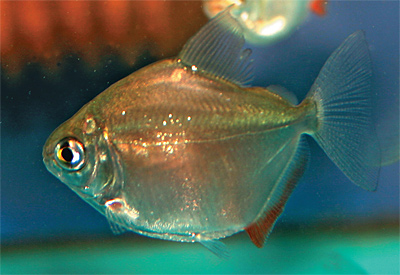
and mileus, close relatives of piranhas -
specialized "herbivorous" fish
and are unlikely to be suitable for an aquarium
with live plants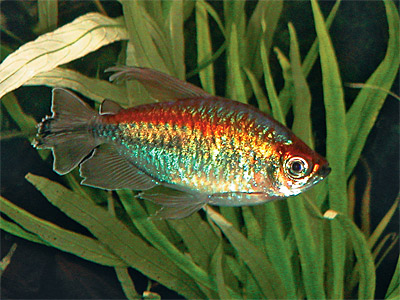
can also damage plants
however, the correct selection of “grass”
and good feeding saves the aquarist
from an unpleasant feature
this magnificent fish
Rhoadsia altipinna is sometimes called
"pink piranha" However, her sharp teeth
are not intended for bloody hunting,
and for gnawing off tasty pieces of aquatic plants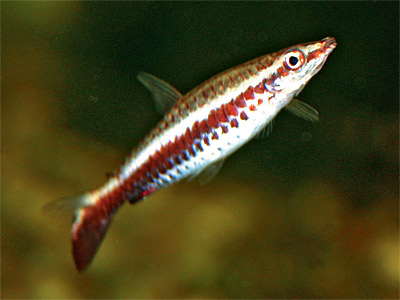
however, he also tries to bite something off the plants
with your microscopic mouth...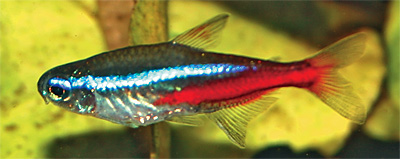
one of the most popular fish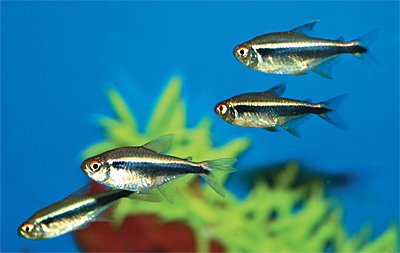
there is no clear hierarchy; Any individual can become a leader,
first to notice danger or food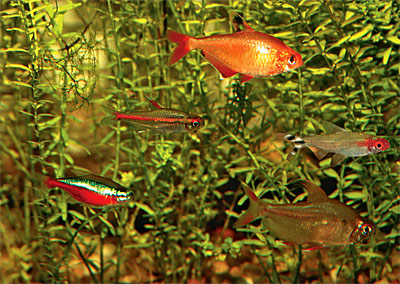
form a common flock in the aquarium,
floating together. This is a very beautiful sight!
It would seem like a very small neon or pecilobricon, whose mouth you can only see through a magnifying glass - and he’s there too, trying to bite something off the plant, and sometimes without success. Many large characin-like fish, such as the American metinnis and mileus or the African distichodas and alestes, are generally specialized phytophages, so their presence in an aquarium with living plants is practically excluded. Although, in fairness, it should be said that a persistent and experienced aquarist can sometimes combine herbivorous characin-like fish in the same aquarium with plants. For example, at the exhibition of the Russian Aquarium club, for several years now there has been a pond in which, among other fish, live large congo fish (Phenacogrammus interruptus) and the herbivorous “pink piranha” (Roadsia altipinna), which eat many species of plants clean. However, it was possible to select the species composition of the composition so that these fish do not touch some types of plants (apparently because they are not tasty for them), while others grow so quickly that they simply do not have time to eat them completely. One such plant is, for example, the willow hygrophila.
Nevertheless, all of the above disadvantages of characin-like fish are compensated by one quality - their unprecedented beauty. Moreover, this beauty can be expressed in various ways. There are simply beautiful fish in themselves, for example, Congo or Rubrostigma. There are those that differ in their original shape (wedge bellies, abramites, ctenolution) or peculiar habits, such as swimming at an angle (like chilodus, pecilobricones or anostomuses). There are also fish with interesting spawning habits, such as copellas, which lay their eggs above the surface of the water and then moisten them by splashing water with the help of their fins.
But the most spectacular and popular characins belong to the family Characidae. These are small species mainly from South America and some from West Africa, which have pronounced gregarious behavior. By themselves, these fish can be very beautiful and have all sorts of luminous stripes, or they can be quite unsightly and gray. Their main charm lies not in color or in the form of one individual, but appears only in a group. This includes the most popular red neons and rhodostomuses in the world aquarium hobby and many other fish known in our country under the collective name “tetras”. All of them have pronounced school behavior.
The sight of several dozen or hundreds of identical characin fish passing in a dense group along a long aquarium can fascinate anyone. But take a closer look, there is discord among the pack. Most often, this is the so-called “flock with a situational leader,” when the role of “leader” goes to any fish that first notices danger or, conversely, food.
But not all characin fish have such a homogeneous school. There are species that form schools with a permanent leader, a hierarchical school: there is the most important fish in the school, a less important one, etc. The role of leaders in these fish is usually performed by males. When determining the leader, the size of the individual and the brightness of the color play a role. The clearest example such fish is royal tetra(Nematobrycon palmeri). Their hierarchy is clearly visible - these fish swim slightly with a downward slope, and the lower the level in the hierarchy, the greater the slope. For a place in the hierarchy, bloodless tournaments take place with a demonstration of fins, their size and color, almost like those of cichlids. Among other things, there are characin fish that form pairs or harem families. This behavior is often found in ornathus-like fish.
Unfortunately, it very often happens that, having planted a fair portion of characinids in the aquarium, the hobbyist rejoices in a real school, when all the fish stay compact, constantly swim in one direction and even in large aquarium occupy a small volume for a fairly short time - usually one or two weeks. Then the dense school disperses, the fish begin to “walk” on their own, and the decorative effect remains, but the impression of schooling is no longer there. What can you do to get the fish back?
First of all, this is a water change. I don't know the mechanism behind this phenomenon, but the fact is that changing the water, preferably straight from the tap, will temporarily bring characin fish back into the school. Organizing a powerful current in the aquarium can also help. If there is not enough water pressure from the filter, you can simply install a special small filter or just a head to create a flow. Then most characins and other fish similar to them in behavior will stay against this current in the way the aquarist wants.
There is a third method, but aquarists do not always manage to apply it correctly. It consists of adding aggressive fish to the aquarium that are so scary for characins that they are afraid of them and support the school, but not predatory enough to eat them. For example, it can work as a “scarecrow” labeo bicolor or medium-sized daytime catfish, but this is not always possible. More promising in this regard are small cichlids from South America (Apistogramma, Laetacara, Geophagus) and some from West Africa (Pelvicachromis, etc.).
One way or another, characin-like fish can decorate any aquarium. They are so diverse and interesting that every aquarist will be able to choose something to his liking from this group.
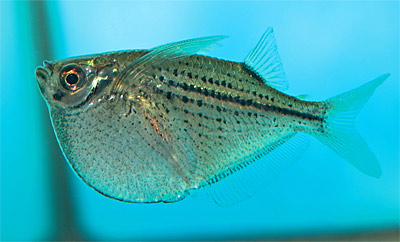
Thanks to the unusual body shape, wedge bellies (Gasteropelecidae) look extremely attractive in the aquarium. Pictured: Gasteropelecus maculatus
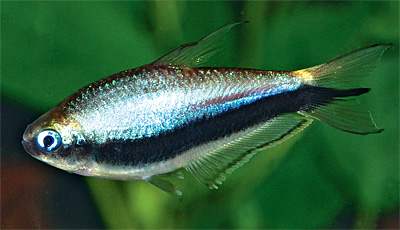
The king tetra (Nematobrycon palmeri) is a typical schooling fish with a hierarchical school structure. By tilting the body, the fish indicates the degree of its leadership or subordination
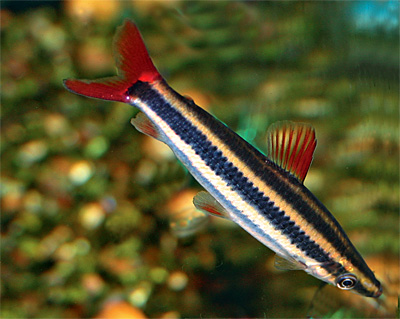
Anostomus anostomus is interesting because it almost always stays in the aquarium upside down, looking for edible particles at the bottom

Thayeria boehlkei (left) and Nannostomus beckfordi (right) 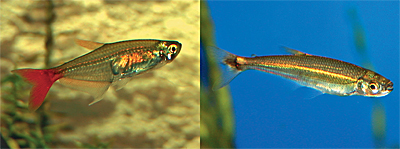
Glass tetra Prionobrama filigera (left) and Iguanodectes spilurus (right) 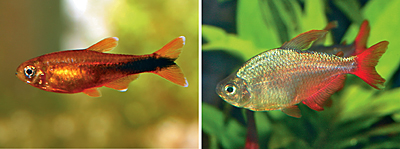
Copper tetra Hasemania nana (left) and Ecuadorian tetra Astyanax sp. (right)
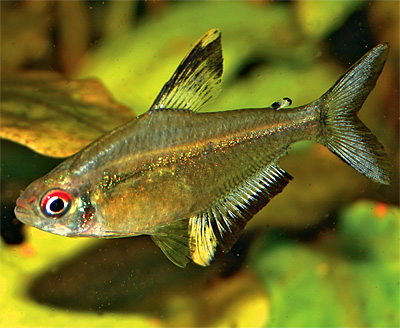
Lemon tetra (Hyphessobrycon pulchripinnis) -
one of the most beautiful among characin fish.
Perfection of body shape and coloring
this representative of the “American tetras”
rightfully makes the lemon tetra real
diamond decorative aquarium
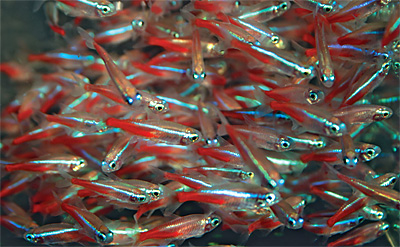
A very great mystery is the question: why do characin fish have such a bright neon, pearlescent, shiny color? Oddly enough, ethologists consensus no on this score and, most likely, a combination of factors plays the main role here. Most likely, bright coloring is needed to recognize fish of their own species, i.e. It is easy for bright fish to keep a school. Also, as can be clearly seen in the photograph, this coloring is protective and disorienting; It is very difficult for a predator from such a flock to isolate and catch an individual(pictured is a flock of Paracheirodon innesi under stress)
Characinidae is a family of freshwater ray-finned fish belonging to the order Characiformes. Their habitat is quite large and extends mostly to tropical and equatorial regions - Central and South America, Mexico, and southwest Texas.
For the most part, they are small, peaceful, schooling fish, and their ecological niche is close to the carp family. Characin fish have become very popular in home aquariums due to their bright colors and ease of breeding.
Common types
The characin family has as many as 12 subfamilies, which in turn consist of 165 genera, and the approximate number of fish species varies from 900 to 1200.
It is curious that one of the characin subfamilies is the well-known piranha, many of which are predatory fish that pose a threat not only to animals, but also to people.
Due to such diversity, it would be incredibly difficult to describe them all, so it is better to touch only on the most common ones, telling about them in more detail.
is a small silver fish with three black transverse stripes on the sides, distinctive feature Males are smaller in size than females, and the color is darker, almost black. There are a number color options bred artificially.
Initially, it lived in the Rio Negro, Paraguay and Mato Grosso rivers, but was then transported to Europe, where it quickly acclimatized and began natural spawning, leaving behind offspring.
This type of fish is energetic and agile; they prefer to gather in separate schools that can attack each other. In a spacious aquarium, they try to be at an average depth and avoid places overgrown with plants. In a small aquarium, on the contrary, they try to hide in plants and only come out to look for food.

- This is one of the most popular fish of the characin family among amateurs; it has a yellowish color, but owes its name to the spots scattered throughout its body, sparkling from the falling light, which resemble diamond edges.
Males are considered more beautiful than females due to their large number of reflective scales, enlarged fins, and the presence of a rich purple tint.
The original habitat of this species of fish is Lake Valencia in Venezuela, however, due to the unfavorable environmental situation, today they mainly come to pet stores from commercial Asian farms.
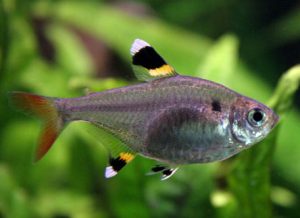
is a small fish that prefers to live in groups, its base color varies from yellowish-green to olive with reflections of silver. It has an almost completely transparent body, making it very popular among aquarium lovers.
This fish is widespread throughout South America; it is found in the rivers of Guyana, the Amazon and the Orinoco. Prefers warm water and dense vegetation.
Compared to other fish characin family, Pristella can exist in absolutely different conditions, which is associated with its special endurance. Individuals of this species are absolutely peaceful, especially when kept in a group of 6 or more individuals, however, they can be timid if large fish are added to them.
Content Features
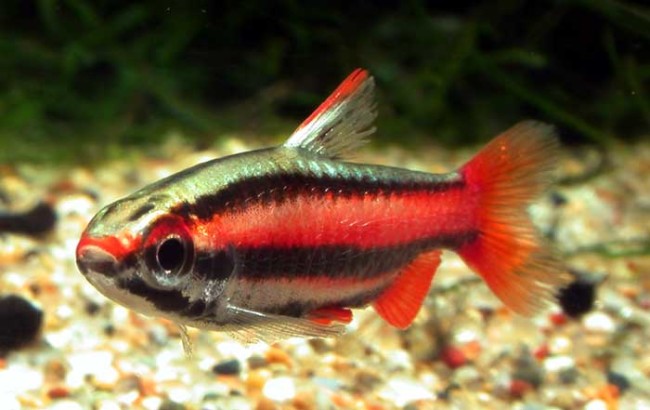
For the most part family of characin aquarium fish unpretentious to the conditions of detention, they quite easily adapt to any conditions. The most important step in getting these pets is choosing an aquarium, determining the type of water and the necessary plants, it is important to answer the following questions:
- What size are the fish?
- What kind of life do they lead?
- What habitat is most familiar to them?
The final choice of the necessary habitat depends on the answers to them. Many individuals of characins are small in size (within 5 centimeters), from this we can conclude that each individual fish needs at least 10 liters of water.
If we add to this the love of this species for flocking, then the size of the aquarium for a minimum number of individuals (5-6) will already be in the region of 50-60 liters. It is because of these factors that the optimal solution is to purchase a mini-reservoir of 100 liters.
It is also important to remember that individuals of this species like to spend time in dense vegetation, and therefore they need to ensure its presence. The first step is to cover the bottom of the aquarium with coarse river sand, and then plant on its sides the plants that are necessary for a particular type of fish. Plants with small leaf blades are often suitable, for example: echinodorus, cryptocorynes, Java moss.
At the same time, it is necessary to regularly replace the water, with an approximate frequency of 1/5 of its volume once a week. It may be useful to use a compressor that would additionally enrich the water with oxygen.
Fish need sufficient diffused lighting.
This type of fish is mainly omnivorous; they can eat both live and frozen food, dry flakes, and also plants.
Behavior and Compatibility
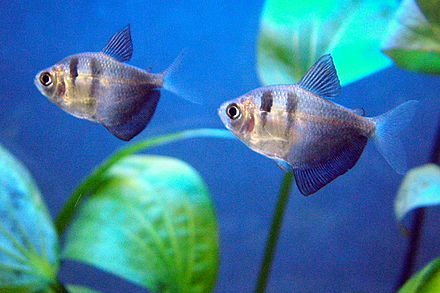 Many aquarium fish characin species are friendly and can coexist with other active and peaceful species of fish; most conflicts occur within their group, rarely going beyond the boundaries and affecting other inhabitants of the aquarium.
Many aquarium fish characin species are friendly and can coexist with other active and peaceful species of fish; most conflicts occur within their group, rarely going beyond the boundaries and affecting other inhabitants of the aquarium.
You should not add too big or too small fish to them; in the first case, they will be scared, and in the second, they will simply torture the little thing.
Some of them have the habit of biting the fins of other fish, this can be corrected by keeping large schools (from 6 individuals), and proximity to fish with large and wide fins is not recommended.
Reproduction
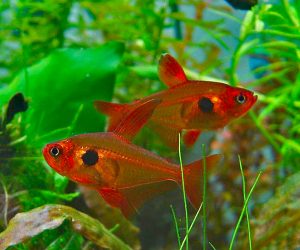 Characin family characterized by rather heavy breeding, which is associated with the seasonality of their reproduction, the need to comply with special temperature regime, the importance of specially prepared water, etc.
Characin family characterized by rather heavy breeding, which is associated with the seasonality of their reproduction, the need to comply with special temperature regime, the importance of specially prepared water, etc.
In addition, this type of fish often eats fry and eggs, which is why it is necessary to create separate conditions for them.
At the same time, many professionals and experienced amateurs easily cope with this process; for this they use a special aquarium for spawning, equip it with a net, an aerator, a thermostat and a small number of plants.
Diseases and life expectancy
This disease can endanger all fish in the aquarium, so before introducing new fish, they must be kept in quarantine for several days to prevent possible infection.
Life expectancy among characin fish varies greatly depending on the species; for ordinary aquarium fish, the average lifespan is around 5 years. Of course, this means that she will be healthy, and for this she needs constant care.
Video about characin fish
The Characin family (lat. Characidae) includes freshwater ray-finned fish belonging to the order Characinidae. According to Eschmeyer, the family is divided into 11 subfamilies, with approximately 1,200 species of fish. Natural habitat is Central and South America, mainly the southwestern regions (Mexico and Texas), where subtropical and tropical climates prevail. Also found in Africa. Characin fish are small schooling fish that belong to the same ecological niche as cyprinids. The Piranha subfamily also stands out as a separate group of the Characin family, but these are already school predators that pose a danger to warm-blooded animals and humans.
The diet and its composition are very diverse - aggressive predators eat live fish (African tiger fish and fago), herbivores feed on vegetation (Prochilodus and Distichodus). Most characins are insectivores.
Characins have a bright body color, so they are often sold as aquarium fish; they are well bred in captivity. It is enough to create an artificial “rainy season” in the nursery by softening the water, changing it often and raising the temperature by several degrees.

Aquarium fish of the Characin family are distinguished by the presence of an adipose fin - a rayless process, which is located on the upper side of the caudal part of the body. All characins, catfishes and salmonids have such a fin. The remains of ancient characins were found in the layers of the Upper Miocene (Tertiary period).
Quickly navigate to the article
Description
Characins are fish small sizes, but bright color with shimmer. They prefer dense, dark areas in warm bodies of water. Representatives of this family easily find their relatives in a pack where there is no clear hierarchical structure. There are no specific leaders, but leadership is determined after a specific situation.
When frightened, their body secretes a special hormone, toribon, which is released when the fish is captured by a predator or when injured. They have perfectly developed olfactory receptors; they find food and their fellow tribesmen even at long distances.
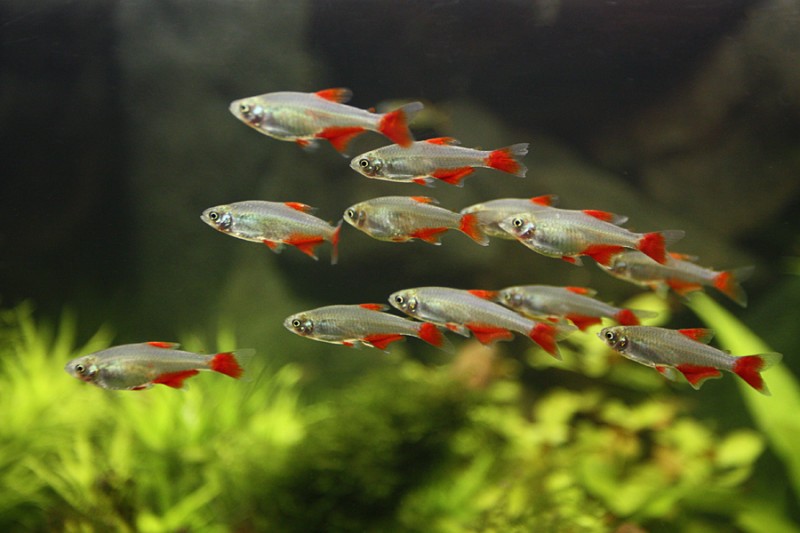
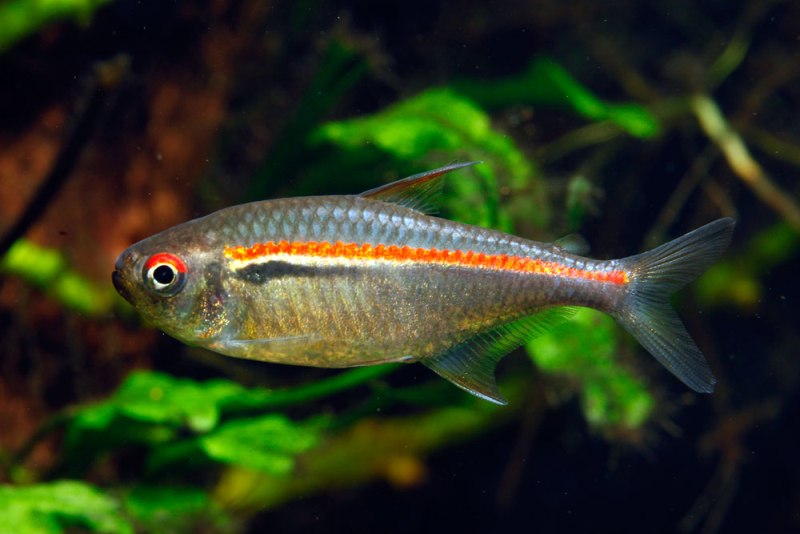
In Africa, fish such as alestes and tinenis, reaching sizes of 10-45 cm in length, have gained industrial importance: they are caught for their fat and delicious meat. Aquarium species of characins are now popular and are available for sale.
Popular aquarium representatives
Representatives of each genus (Alestes, Mikralest, Bricinus, Phenacogrammus, Arnoldichthys, Ladigesia and Lepidarchus) are similar to each other in the same requirements for living conditions. The most common aquarium species of such fish are:
- African tetras;
- Dwarf characin and Adonis characin;
- Distichodes;
- South American tetras;
- Nannostomus;
- Splashing Tetras;
- Wedge-bellied;
- Striped Smallmouth;
- Piranhas.
Take a look at the dwarf characins.
Characins are aquarium fish small and medium in size, reaching an average body length of 10-15 cm, and this is in captivity. All species are easy to keep at home and reproduce quickly in spawning grounds. Aquarium conditions should be close to natural, so tanks with dense vegetation and free space for movement are suitable. Since in the wild they nest in flowing waters with clean water, sensitive to water pollution and chemicals.
We recommend soft or medium hard water, in which the fish will be ready to reproduce. Once every 1-2 weeks, 20-30% of the water should be replaced with fresh and clean water. Fresh water should not differ in its parameters from aquarium water.
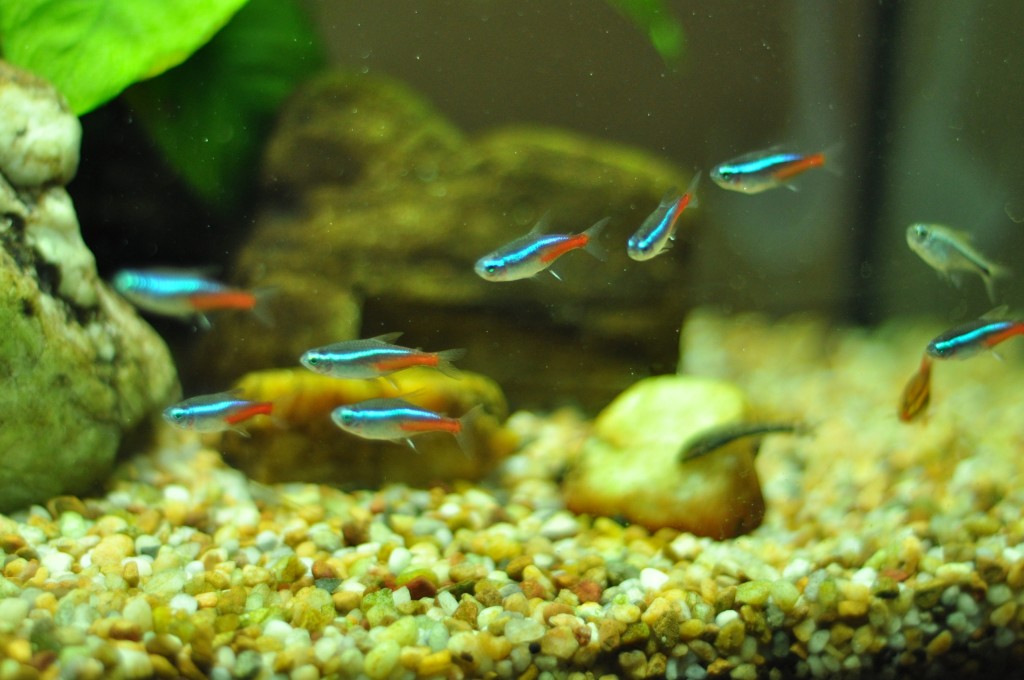
The lighting is better soft and diffused; in the nursery it is better to create areas with shade where sunlight does not penetrate. There the fish recover and rest. To see the rich color of their color, it is recommended to line the bottom of the container with dark soil. It is important to cover the aquarium with a lid to prevent pets from jumping out.
They eat frozen, dry and live food. Predators should be fed only live fish. Some fish may have their fins torn off.
See representatives of the characin family in the company of dwarf cichlids
Breeding characins
With the right selection of partners, you can get large offspring. Neon breeding is problematic. Sexual differences are not difficult to determine - females are larger than males, their bodies are more rounded, which is very noticeable during the formation of eggs. The stripes on the body of males are straight, while those of females are curved. To reproduce small characins, you should select individuals that have reached a size of 2-3 cm.
Before spawning of characins, future parents must be given live food - daphnia and artemia. The level of acidity and hardness of the water decreases, the fish do not immediately get used to the spawning ground, preparation, both physical and psychological, can take 2-3 weeks. To soften the pH, distilled water is added to the spawning area. The volume of the spawning aquarium is 50 liters. Before placing fish in it, the tank is treated from germs. You can also add several handfuls of peat to the nursery, which after 2 days will sink to the bottom, adding water brown. Peat reduces the acidity of water.
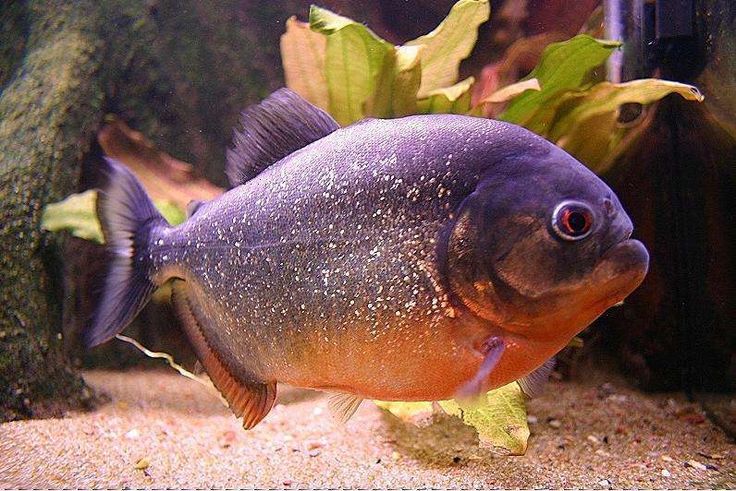
After obtaining reliable water parameters, it should be heated to a temperature of 24-26 degrees. Use a nylon spawning sponge, preferably new or cleaned.
When the spawning area is ready for the future parents to move in, you can turn off the lights and place them there overnight. In the morning you will see fish huddled together for two hours. It looks like the male is hugging the female. New eggs appear every minute, tightly glued together. About 150 eggs appear in one cycle. After spawning, the pair is placed in another container.
There were cases when the fish were not ready to give birth, so they were left in the spawning tank for a few more days. If all else fails, it is better to choose another pair of fish, but not earlier than in a week or two. An updated aquarium should have clean and fresh water.
After removing the parents from the spawning area, cover the egg tank from light using brown paper to avoid excess light. The next day the larvae hatch, and after three days they will float freely in the water. The first food is ciliates and food for fry; after a week you can transfer them to young brine shrimp. The fry grow quickly, and after 2 weeks the first sexual differences will appear.


























